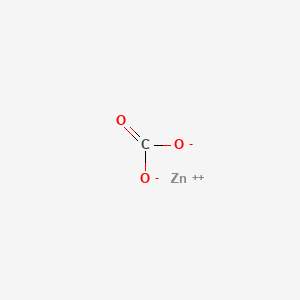



1. 3486-35-9
2. Zinc Monocarbonate
3. Zinc;carbonate
4. Carbonic Acid, Zinc Salt (1:1)
5. Zinccarbonate
6. Zinc Carbonate (1:1)
7. Ci 77950
8. Zinc Oxide Transparent
9. C.i. 77950
10. K8290ptq4f
11. Zincspar
12. Natural Smithsonite
13. Hsdb 1048
14. Einecs 222-477-6
15. Unii-k8290ptq4f
16. Zinc Carbonic Acid
17. Zinc(ii) Carbonate
18. Carbonic Acid Zinc Salt
19. Zinc Carbonate [mi]
20. Schembl20746
21. Dtxsid5049817
22. Zinc Monocarbonate [hsdb]
23. Chebi:184449
24. Zinc(+2) Cation Carbonate
25. Mfcd00041957
26. 10476-83-2
27. C.i.77950
28. Ft-0774765
29. Q204661
| Molecular Weight | 125.4 g/mol |
|---|---|
| Molecular Formula | CO3Zn |
| Hydrogen Bond Donor Count | 0 |
| Hydrogen Bond Acceptor Count | 3 |
| Rotatable Bond Count | 0 |
| Exact Mass | 123.913886 g/mol |
| Monoisotopic Mass | 123.913886 g/mol |
| Topological Polar Surface Area | 63.2 Ų |
| Heavy Atom Count | 5 |
| Formal Charge | 0 |
| Complexity | 18.8 |
| Isotope Atom Count | 0 |
| Defined Atom Stereocenter Count | 0 |
| Undefined Atom Stereocenter Count | 0 |
| Defined Bond Stereocenter Count | 0 |
| Undefined Bond Stereocenter Count | 0 |
| Covalently Bonded Unit Count | 2 |
MEDICATION (VET): ASTRINGENT, ANTISEPTIC, PROTECTIVE (TOPICAL). ALSO USED IN RATIONS TO PREVENT ZINC DEFICIENCY DISEASES.
Budavari, S. (ed.). The Merck Index - Encyclopedia of Chemicals, Drugs and Biologicals. Rahway, NJ: Merck and Co., Inc., 1989., p. 1598
MEDICATION (VET): Zinc carbonate is used as a dietary supplement for farm animals.
Seiler, H.G., H. Sigel and A. Sigel (eds.). Handbook on the Toxicity of Inorganic Compounds. New York, NY: Marcel Dekker, Inc. 1988., p. 789
Astringent, topical antiseptic.
Budavari, S. (ed.). The Merck Index - Encyclopedia of Chemicals, Drugs and Biologicals. Rahway, NJ: Merck and Co., Inc., 1989., p. 1598
The effects of different amounts of dietary zinc on the zinc absorption rate and on zinc, calcium and magnesium concn in tissues of MOPC104E tumor bearing Balb/c female mice were determined. Three groups of 7 mice each (each mouse inoculated with approx 1.25 million MOPC104E cells) were given one of three experimental diets containing adequate amounts of zinc (40 ug zinc/g), a zinc deficient diet (1.0 ug zinc/g), or a zinc excess diet (1 mg zinc/g). A group of 7 nontumor bearing mice was fed laboratory mice chow as a control. The zinc deficient diet contained 37.5 ug zinc/g. For the zinc adequate diet, 71.0 mg zinc carbonate/kg diet was added to the zinc deficient diet. For the zinc excess diet 1917.9 mg zinc carbonate/kg diet was added. After 14 days on the special diets, mice were given an intragastric dose of a 200 ul solution containing 0.37 MBq (65)zinc (specific activity: 37 MBq/mg). (65)Zn was determined in various organs by gamma counting. Another set of 28 mice were placed in the same experimental conditions as described above. After anesthesia with nembutal injection, each organ was analyzed for concn of zinc, calcium, and magnesium by atomic absorption spectrophotometry. The zinc absorption rate was inversely related to the amounts of zinc in the diet and was lower than that of nontumor bearing control mice fed a laboratory mice chow. Zinc concn of tumor bearing mice were also low compared with control mice but tumor zinc concn, regardless of the concn of zinc in the diets, were higher than those of normal tissues of the host other than the pancreas.
PMID:2929490 Song MK et al; Am J Clin Nutr 49 (4): 701-7 (1989)